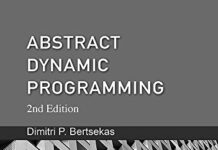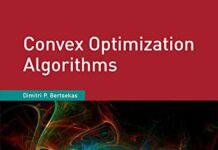
Ebook Info
- Published: 1996
- Number of pages: 410 pages
- Format: PDF
- File Size: 16.38 MB
- Authors: Dimitri P. Bertsekas
Description
This widely referenced textbook, first published in 1982 by Academic Press, is the authoritative and comprehensive treatment of some of the most widely used constrained optimization methods, including the augmented Lagrangian/multiplier and sequential quadratic programming methods. Among its special features, the book: 1) treats extensively augmented Lagrangian methods, including an exhaustive analysis of the associated convergence and rate of convergence properties 2) develops comprehensively sequential quadratic programming and other Lagrangian methods 3) provides a detailed analysis of differentiable and nondifferentiable exact penalty methods 4) presents nondifferentiable and minimax optimization methods based on smoothing 5) contains much in depth research not found in any other textbook
User’s Reviews
Editorial Reviews: Review “This is an excellent reference book. The author has done a great job in at least three directions. First, he expertly, systematically and with ever-present authority guides the reader through complicated areas of numerical optimization. This is achieved by carefully explaining and illustrating (by figures, if necessary) the underlying principles and theory. Second, he provides extensive guidance on the merits of various types of methods. This is expremely useful to practitioners. Finally, this is truly a state of the art book on numerical optimization.” –S. Zlobec, SIAM Review About the Author The author is McAfee Professor of Engineering at the Massachusetts Institute of Technology and a member of the National Academy of Engineering.
Reviews from Amazon users which were colected at the time this book was published on the website:
⭐Excellent treatise on constrained optimization done the classic way with Lagrange multipliers. A must have for any mathematician. The author is a leading expert in the field, and the proofs of theorems are exceptionally well written. From the perspective of application, though the book is mainly theoretical in extent, the methods presented go well beyond basic KKT methods.
⭐good book very clear and comprehensive
⭐The focus of this book stems from the author’s research work with Augmented Lagrangian (a.k.a. “method of moments”) techniques between 1972 and 1981. Since then, many new approaches (e.g., SQP, GRG, trust-region methods, interior point methods) have gained favor for their greater efficiency and robustness. Even so, Augmented Lagrangian methods remain relevant and interesting, in part because of their relationship to some newer approaches.Unfortunately, the author’s presentation is awkward and unnecessarily difficult. In fact, the book is little more than a formal recitation of mathematical proofs for variant algorithms. Little emphasis is placed upon teaching, although great effort is made to itemize the specific accomplishments of different researchers (at the end of each chapter). The author of this book is mentioned frequently. Those not already familiar with the subject matter will find this book impossibly frustrating, despite assurances from the author that no prior background in this field is required. There are few examples or illustrations, and an incredible sparsity of explanations. Even for those readers possessing prior knowledge, the text is likely to be unrewardingly concise. For example, there is little discussion regarding the relative efficacy of the different algorithms, either with respect to one another, or to other approaches not covered by the book.Despite these serious shortcomings, the book may find some use as an occassional supplement or reference for researchers interested in the author’s commentaries and insights about the various Augmented Lagrangian algorithms. A brief survey of some other lagrangian approaches is also included. This book, and a number of other more current ones, are currently available through the author’s own publishing company, Athena Scientific.Another book is available which treats the Augmented Lagrangian approach in a much more practical and accessible fashion:”Mathematical Programming Via Augmented Lagrangians; An Introduction with Computer Programs”, by Donald A. Pierre and Michael J. Lowe. It contains an in-depth presentation of one well-known program (NPNLP), complete with fortran source code, documentation, supporting theory, and comparative benchmarks.For a more introductory coverage of Augmented Lagrangian methods, any of the following books are good:1) “Engineering Optimization – Theory and Practice”, S.S. Rao2) “Engineering Optimization – Methods and Applications”, Reklaitis, et al.3) “Nonlinear Programming” – Bazaraa4) “Practical Methods of Optimization” – Fletcher
⭐Not at all useful for learning the subject. I don’t know who the target audience are for this book.
Keywords
Free Download Constrained Optimization and Lagrange Multiplier Methods (Optimization and neural computation series) 1st Edition in PDF format
Constrained Optimization and Lagrange Multiplier Methods (Optimization and neural computation series) 1st Edition PDF Free Download
Download Constrained Optimization and Lagrange Multiplier Methods (Optimization and neural computation series) 1st Edition 1996 PDF Free
Constrained Optimization and Lagrange Multiplier Methods (Optimization and neural computation series) 1st Edition 1996 PDF Free Download
Download Constrained Optimization and Lagrange Multiplier Methods (Optimization and neural computation series) 1st Edition PDF
Free Download Ebook Constrained Optimization and Lagrange Multiplier Methods (Optimization and neural computation series) 1st Edition



